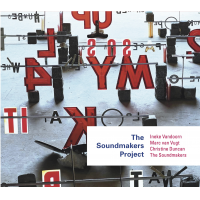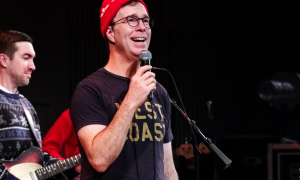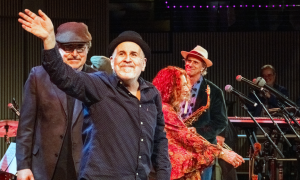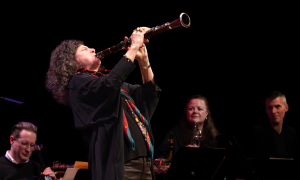Home » Jazz Articles » Live Review » ISO e.s.t
ISO e.s.t
Svensson's composing possesses a macro vs. micro awareness that is refreshing and is the focus of the music, but it's clear that these three musicians function as one organism.
 Wanted: Jazz trio with the nuance of a dancer, the subtlety and chops of a diamond cutter and the expertise to teach it in Braille. Must be willing to consistently show both love and logic in the face of little recognition of their idiom and a smothering cacophony that believes only in bloodletting, cookie-cutter music.
Wanted: Jazz trio with the nuance of a dancer, the subtlety and chops of a diamond cutter and the expertise to teach it in Braille. Must be willing to consistently show both love and logic in the face of little recognition of their idiom and a smothering cacophony that believes only in bloodletting, cookie-cutter music.Despite some logistical issues with the audience, The Esbjorn Svensson Trio fulfilled those requirements November 13th at the Michigan Theater in Ann Arbor. A trio made up of piano, bass and drums in their second tour of the U.S., they gave equal time to their newest album just released here in the U.S., Seven Days of Falling, and their last release, Strange Place for Snow. Natives to Sweden and the hottest jazz trio in Europe right now, they have just released a live DVD, Live in Stockholm, and won the European Jazz Award for 2004.
You could say from his style that the pianist and leader, Esbjorn Svensson, has heard Jarrett and Monk, but a good musician always sounds like themselves; he possesses a lyricism that is uniquely his own. Jazz being what it is, today's darling may be tomorrow's trivia, but Svensson has the potential to make it last. He works his melody lines like jewels, but tempers the melody to diamond-like permanence. "Elevation of Love" and "Why She Couldn't Come," two sides of the same dichotomy, elevated the music to soliloquies of the human heart, each possessing its own truth. He bends over his piano as if wearing a jeweler's loop and attacks each note with an intensity that stands as a lesson to the rest of us.
Svensson's composing possesses a macro vs. micro awareness that is refreshing and is the focus of the music, but it's clear that these three musicians function as one organism. The encore, "Behind the Yashmak" was a pelting drive down the Autobahn at 180 km/hr with the accuracy and timing of a laser. Each had their own sound; Dan Berglund, as well as being an eloquent bassist, applied an electronic phase-lag technique to his acoustic bass that gave it a haunting resonance, almost as if it possessed a human voice. Magnus Ostrom lives up to his name in Swedish, Ostrum translates as "island/stream" and the comparison was striking, his drumming provided the hypnotic flow for the music but maintained his own identity. Gone are the days when they were 13 of Ostrum missing rehearsals, engendering being temporarily "fired" by Svensson. It honed their musical mission, however, as they discovered that they were miserable not playing music together, which then evolved into e.s.t.
 The second bill, The Bad Plus, a jazz Jam band with its own group of loyalists in attendance, was well-schooled and demonstrated a dynamic power in their set. But while at first glance this may appear like a good fit with e.s.t. because of their overall similarities in construction, they really appeal to a different audience. Well known for their wacky covers of rock classics and danceable tunes, this pairing might benefit from rethinking the marketing strategy. Their own composition, "Rhinoceros Is My Profession" and a raucous cover of the Queen classic, "We Are The Champions" were a credible attempt to take the walls out, but were overwhelming in comparison to the lyrical subtlety of e.s.t.
The second bill, The Bad Plus, a jazz Jam band with its own group of loyalists in attendance, was well-schooled and demonstrated a dynamic power in their set. But while at first glance this may appear like a good fit with e.s.t. because of their overall similarities in construction, they really appeal to a different audience. Well known for their wacky covers of rock classics and danceable tunes, this pairing might benefit from rethinking the marketing strategy. Their own composition, "Rhinoceros Is My Profession" and a raucous cover of the Queen classic, "We Are The Champions" were a credible attempt to take the walls out, but were overwhelming in comparison to the lyrical subtlety of e.s.t.
Jazz is about everything between love and logic, and e.s.t.'s tales tell all the stories that belong to us. No grandstanding, metaphorical flag-waving, or "Look Ma, no hands!" here. The moments that get washed away all too easily in the face of a culture that constantly screams that more is never enough are what e.s.t. addresses. Sometimes the truth whispers and sometimes it roars, and these young men show us how to hear it.
Tags
PREVIOUS / NEXT
Support All About Jazz
 All About Jazz has been a pillar of jazz since 1995, championing it as an art form and, more importantly, supporting the musicians who make it. Our enduring commitment has made "AAJ" one of the most culturally important websites of its kind, read by hundreds of thousands of fans, musicians and industry figures every month.
All About Jazz has been a pillar of jazz since 1995, championing it as an art form and, more importantly, supporting the musicians who make it. Our enduring commitment has made "AAJ" one of the most culturally important websites of its kind, read by hundreds of thousands of fans, musicians and industry figures every month.
























